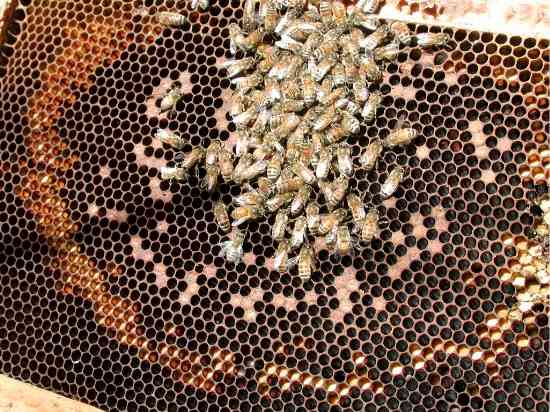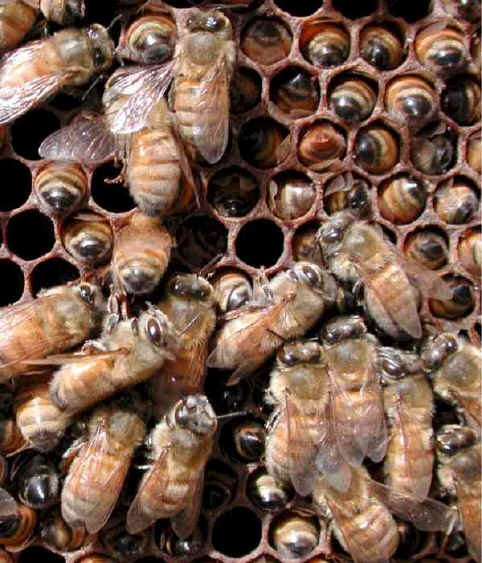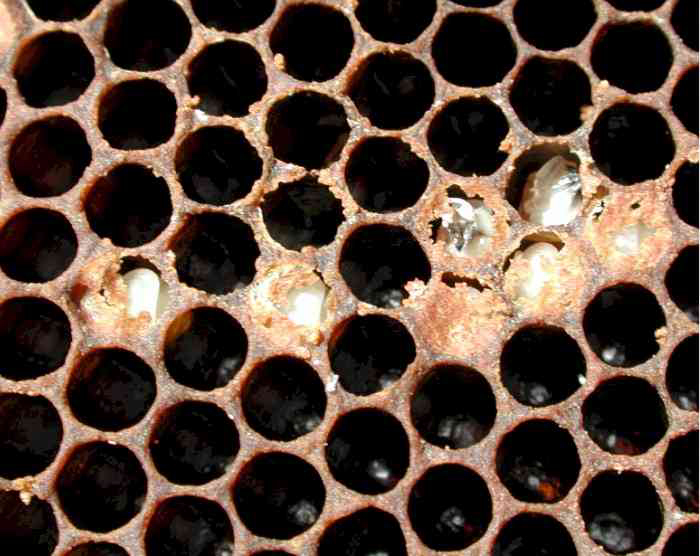
Image copyright 2002, by David L. Green
Most of the bees of this once powerful hive have died and fallen to the bottom of the hive, some are here quivering.
Most of the brood is uncovered and dead. The queen cannot be found, and is presumed dead.
Starving Bees
A common mistake for inexperienced beekeepers is to assume, too soon, that the bees have made it through the winter. The sight of spring flowers and bees visiting them, makes the keeper think the bees will now feed themselves. Sadly this is not always true.
Cold nights limit the hours bees can work. They cannot start until it warms up, sometimes in late morning. Plus it may frost and actually kill the blossoms, so bees can get no benefit from them. Overcast skies prevent photosynthesis, and reduce nectar production. 0ftentimes the first real nectar flow is quite awhile after the first spring flowers appear. It generally takes sustained warm weather and plenty of sunshine for most flowers to yield nectar. (There are exceptions to this, such as brassicas. If you can have some canola, or collards that overwinter and bloom early, these are prized flowers because they can actually freeze and still produce nectar within a couple hours.)
At the same time food requirements have increased exponentially, as the bees are raising large quantities of brood for the future field force, to bring in the spring nectar flow. It is very easy for a hive at this time to outrun its reserve food supply. Just a few cloudy, rainy, or cold days can mean sudden starvation for the hives of an inattentive beekeeper.

Image copyright 2002, by David L. Green
Most of the bees of this once powerful hive have died and fallen to the
bottom of the hive, some are here quivering.
Most of the brood is uncovered and dead. The queen
cannot be found, and is presumed dead.
This affliction most commonly affects the strongest and best hives. It is a sad sight to see a powerful hive die or be devastated by starvation, just before they could have turned around and begun building food reserves.
Here in coastal South Carolina, we see a flush of spring bloom, beginning in early March. But I've never seen the real spring flow until the end of March in the earliest years, and with late frosts, it may be the tenth of April or later. In your area the dates may be different, but the principle is the same. Find out from experienced local beekeepers when the real spring flow commences.

Image copyright 2002, by David L. Green
Often the last thing a bee does before expiring is to crawl into a
cell.
At this time of year, never assume! Hives that were heavy a month before may now be feather light. Check, check, check!
A hive that begins to starve will suck the body fluids from the brood, in the attempt to save the colony.

Image copyright 2002, by David L. Green
Some of the brood has been chewed and sucked of body fluids in an
attempt for the adults to survive.
Even if they survive, the colony has lost its spring flush of growth. The "cow" has aborted its "calf" (the spring divide you could have made) and may have also lost its ability to bring in a spring honey crop. The queen may be damaged (or dead) and need replacement ASAP. Brood that appears undamaged may actually be dead, because the bees did not have the energy (or population) to keep it warm; it may be chilled.
You can get an idea of a hive's food reserves by hefting the back of the hive, but this is somewhat subjective and must be based on quite a little experience. You can also pop the top and look down between the frames. You should be able to see capped honey on some of the frames. In evaluating the food reserves NEVER count nectar/honey that isn't capped, because it can disappear in a day or so.
If you have hives with no capped honey, feed, feed, feed. And be quick about it. You can feed syrup or frames of honey that have been saved for spring feed. But do it! Bees that you find quivering can sometimes be revived, depending on how badly they have been affected, by dusting them with powdered sugar, or drizzling syrup over them.
Weakened and starving bees may not get nectar, because they don't have enough sugar reserves to power their wing muscles. A wise old beekeeper once told me, "If the bees FEEL prosperous, they will BEE prosperous." Don't let the spring build up falter for even a day.
Sometimes the tail end of winter turns into a day by day race for the bees, to see if they can hold on until the real nectar flow gets going. I've seen wild hives that put out tremendous flight on a nice day in early March, be completely dead March 20, just a week or so before they could have made it, here in coastal South Carolina.
One day, after a warm shower, the sun will shine and the bees will be jamming nectar in every open cell, preventing the queen from laying eggs.. The next day, they begin making swarm cells. It can literally turn from famine to feast overnight, and the beekeeper is now dealing with another problem - swarm season.